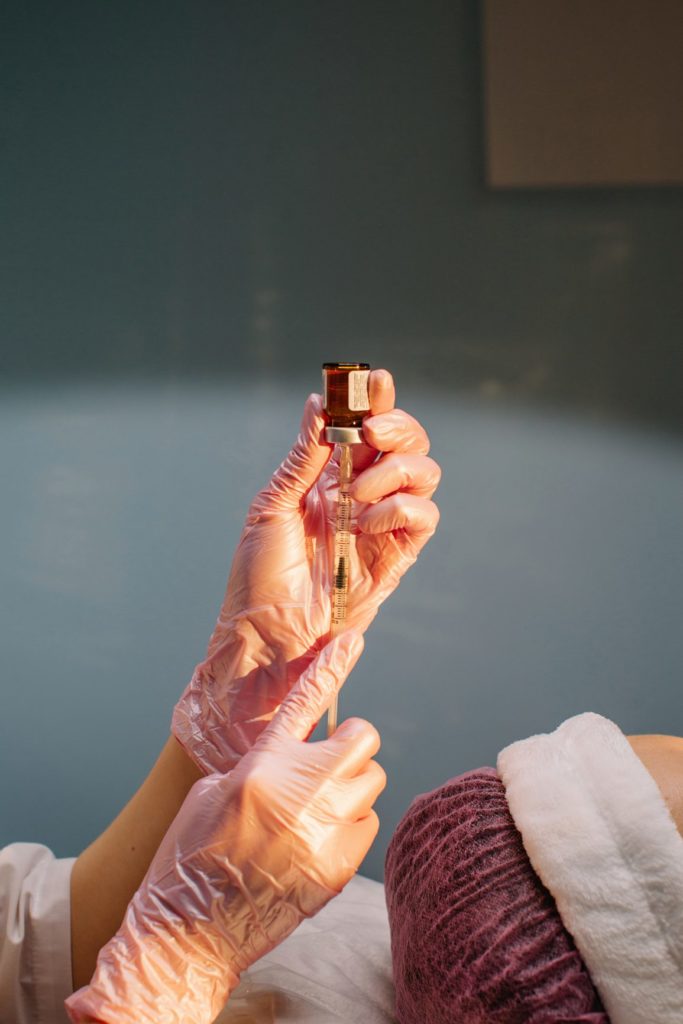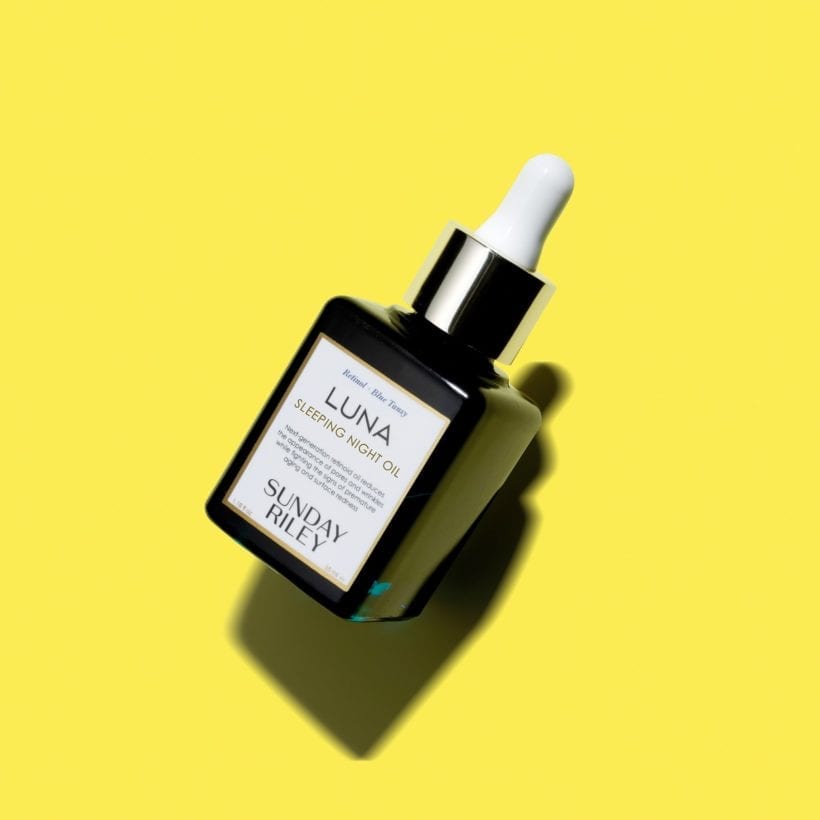In her essay, “I Feel Bad About My Neck,” Nora Ephron famously wrote, “My own experience with my neck began shortly before I turned forty-three.” Me too! It’s the crepey, thinly-lined skin that slopes from chin to neck that gets me, but I’ve heard friends lament their wrinkles and loose skin. Ephron added, “Short of surgery, there’s not a damn thing you can do about a neck.” Well, that may have been the case 15 years ago when the award-winning journalist and filmmaker penned this piece, but nowadays, there are options. “There are many things you can do to help stave off this inevitable decline in the integrity of the neck skin,” says L.A.-based cosmetic injector Kristina Kitsos, who adds that the neck skin, along with the upper eyelids, “is some of the thinnest skin on the body and quickly shows signs of aging before other areas.” So. What are the options?
At-Home Treatments
Let’s start with the easiest option: Skincare. First off, is it necessary to pick products designed for the neck, as in neck creams? No, says Kitsos. “There is no benefit to using products targeted specifically for the neck.” Whatever you use on the face needs to be smoothed down to the decollete. Kitsos recommends products with “a low dose of retinol and hyaluronic acid and niacinamide.”
Dr. Blair Murphy-Rose, a board-certified dermatologist at Laser & Skin Surgery Center of New York, also recommends topical antioxidants like vitamin C. Tick these boxes by using the Sunday Riley Bright Young Thing kit for daytime and Luna Oil at night.
Dr. Murphy-Rose also suggests Currentbody Skin LED Light Therapy Mask, which can come with a neck and décolletage panel to target those areas. “It can help improve signs of photo-aging from your own home by stimulating collagen and elastin levels in a 10-minute session of red and near-infrared light.”
In-Office Treatments
Ready for something more intensive? Botox is often Kitsos’ first line of attack, saying it “helps the constant and insidious downward pull of the lower face and neck area.” Dr. Murphy-Rose adds that Botox can be a great option for those with “strong platysma muscles causing bands or wrinkles.” (Platysma bands are those visible cords that run up the neck vertically.) Price varies greatly depending on the treatment area and the amount of neuromodulators (Botox, Dysport and XEOMIN are the most common ones). Still, Dr. Murphy-Rose says the range is between $500 to $1,000 per treatment, lasting about four months. Botox is also a preventative treatment, says Kitsos. “If you start in your 30s, your neck and lower face will always appear about 10 years younger than your true age.”
Fillers like Hyperdilute Radiesse and Sculptra are two that Kitsos uses “to create a thicker, more resilient skin in the neck area.” She says it’s “akin to spreading out seeds that grow collagen — it helps to give the skin more structural integrity.” But don’t think of fillers as overinflated lips and cheeks; in the neck, it gives “natural, taut skin,” says Kitsos. (Prices are similar to neuromodulators.)

Another line of attack are threads. Dr. Murphy-Rose explains that during a thread lift, dissolvable sutures (like what are used for getting stitches) are inserted under the skin then pulled back and secured in place to tighten a desired area of tissue. “There is an immediate tightening effect and an additional delayed anti-aging effect due to the threads boosting one’s own collagen production in the skin.” The average cost of a thread lift is $3,000 and lasts one to three years.
Lasers are another option, explains Kitsos. “Heat and laser energy causes a little bit of damage, which then signals your body to repair that damage and your skin comes back stronger.” She says, “The key here is to know exactly how much is too much. If you do too little, it won’t make any difference; if you do too much and the treatment is too aggressive, that can have lasting negative side effects.” It generally takes between two and five treatments (once per month) to see changes in the neck skin. One session costs between $600 and $1,000 on average.
Likewise, radiofrequency uses energy to heat the dermis and stimulate collagen production. “It is a slower process and requires more treatments than many of the other modalities but is good for people that have zero pain tolerance,” says Kitsos, who recommends radiofrequency in conjunction with microneedling, which uses tiny needles to damage the skin and prompt it to generate new collagen. Dr. Murphy-Rose says, “Sofwave, an ultrasound device, and Genius RF microneedling have shown impressive results in clinical trials.” These treatments usually cost between $1,500 and $2,500.
As you can see, “There are many different procedures that can be used together to give you the optimal results,” says Kitsos. “By themselves they are good; together, they are amazing.”
The bottom line: See a professional in your area to discuss the best options for your neck, budget and time frame.
Surgery
If you tighten up the neck, you’ve also got to tighten up the face.
In Ephron’s essay, she writes that if you want a neck lift, any decent plastic surgeon will tell you to get a facelift as well. “And he’s not lying. He’s not trying to con you into spending more money. The fact is, it’s all one big ball of wax. If you tighten up the neck, you’ve also got to tighten up the face.” Kitsos says that a neck lift can be a great option “when the skin is very saggy,” but they don’t do anything for the structural integrity, i.e. firming up the area. “The skin is still thin, just pulled tighter.” (Unlike the other treatments listed above, which she says “actually thicken skin.”) A neck lift typically runs more than $5,000, and that’s not including operating room facilities, anesthesia and other related expenses. Results typically last 10 to 15 years.
A mini or micro neck lift is less invasive than a full neck lift and costs less. It has less recovery time and lasts two to five years, on average. (Though used in conjunction with the in-office treatments listed above, it can help extend its life.)
Prevention and Healthy Living
Though we’re all destined to have aging necks, how much of a role do genetics play? Can you look at your grandma to see the destiny of your waddle? “Genetics play a big role in how your skin ages, but it isn’t the whole story,” explains Dr. Murphy-Rose. “While your skin may age similarly to the skin of some family members — both women and men — it is not a guaranteed predictor.” Kitsos adds that “People with light hair and fair colored skin tend to age the fastest,” and therefore need to be the most diligent about things like SPF. Sun protection is essential: “Protect that skin from ultraviolet light. Zinc oxide-based sunscreen and broad-brimmed hats (not baseball caps) are always a must,” insists Kitsos.
How are your hormone levels? “You may want to have estrogen levels checked, as low levels can lead to thin and diminished skin health,” advises Kitsos. That’s right: Normal levels of estrogen can increase collagen production and minimize signs of aging.
So there we have it. The top options for hating (and maybe even accepting) our necks. If nothing else, take comfort in knowing that aging necks are a universal condition.
We only recommend products we have independently researched, tested, and loved. If you purchase a product found through our links, Sunday Edit may earn an affiliate commission.









